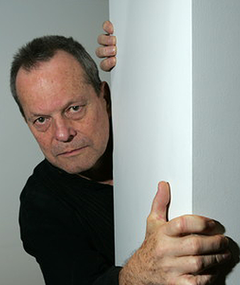| Gilliam, Terry
 |
Birth name
Terence Vance Gilliam
Date of birth
22 November 1940, Minneapolis, Minnesota, USA
Mini biography
Terry Gilliam (November 22, 1940, Minneapolis, Minnesota, USA)
Born in Minneapolis, Minnesota, on November 22, 1940, Gilliam was briefly employed by Mad Magazine as a writer/illustrator before he emigrated to England in 1967.
Soon after he arrived in the U.K., he began working on Do Not Adjust Your Set, a popular children’s TV show, developing his eccentric animated cartoons.
“You get trapped by stories. Though I've got this reputation for being out of control, it's not true, it just happens to be a more interesting story than the truth.”
Gilliam’s contributions to the show were geared more toward adults, as his surrealistic stream-of-consciousness segments, drenched in black humor, were beyond the grasp of most children. In 1969, Gilliam was asked to join the absurdist comedy troupe Monty Python.
In addition to writing for Monty Python’s Flying Circus, Gilliam also contributed his animated interludes. Gilliam began offering his iconoclastic vision to moviegoers with the comedy troupe’s first original film, Monty Python and the Holy Grail (1975), which he co-directed with fellow Python Terry Jones.
The following year, Gilliam had his first outing as a solo director with Jabberwocky (1976), based on the poem by Lewis Carroll. Along with Python’s brand of irreverent humor, the film featured glimmers of the visual resplendence that would become the director’s trademark. Following Jabberwocky’s relative failure, Gilliam regrouped with his fellow Pythonites, co-creating The Life of Brian, the tale of a man with the misfortune of being confused with Jesus Christ.
Gilliam returned to directing with Time Bandits (1979), a surreal journey through history.It did well at the box office and put Gilliam in the ranks of directors to watch. After co-directing with Terry Jones the third and final Python film, Monty Python’s the Meaning of Life (1983), Gilliam made what many people consider his masterpiece, the dystopian satire Brazil (1985).
Consistently blurring the line between fantasy and reality and uncompromising in its surreal eccentricity, Gilliam’s masterwork has been called Orwellian, Kafkaesque, and Luddite. In addition to critical praise and a Los Angeles Film Critics award for Best Film, Gilliam received an Oscar nomination for Best Original Screenplay.
It was four years before Gilliam stepped behind the camera again, for The Adventures of Baron Munchausen (1989), which the film won British Academy Awards for Best Production Design, Best Makeup, and Best Costume Design. Gilliam followed Munchausen with his most accessible work to date, 1991’s The Fisher King, which balances humor, pathos, and story-telling, while avoiding mawkishness. Gilliam received a Golden Globe nomination for Best Director, and the movie won the Silver Lion Award at the Venice Film Festival.
Gilliam returned to the director’s chair in 1995, achieving his biggest box office hit with the science fiction epic 12 Monkeys. Starring Bruce Willis, Madeleine Stowe, and Brad Pitt. The film was a critical and commercial success. His next project, Fear and Loathing in Las Vegas (1998), an adaptation of Hunter S. Thompson’s 1971 novel, was the ultimate “trip” movie. Detailing Thompson’s drug-addled journey to the gambling capital of the world, it starred Johnny Depp as the author’s alter ego, Raoul Duke.
When Gilliam attempted to film his lifelong dream project, The Man Who Killed Don Quixote, in late 2000. From injured actors to faulty props to inclement weather conditions, the $30 million shoot became a textbook example of Murphy’s Law, and was shut down despite pleas from the haggard director. However, the project found new, unexpected life in Keith Fulton and Louis Pepe’s documentary Lost in La Mancha, a comic tale of cinematic defeat, which minor art-house attraction. -- all movie
Director - Selected filmography
-
The Imaginarium of Doctor Parnassus (2009)
-
Brazil (1985)
|

